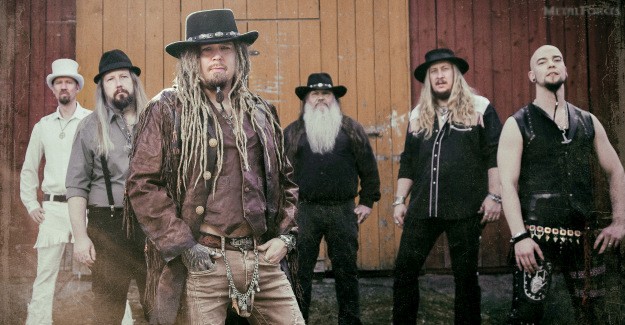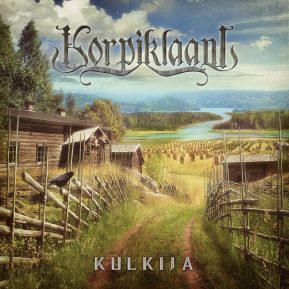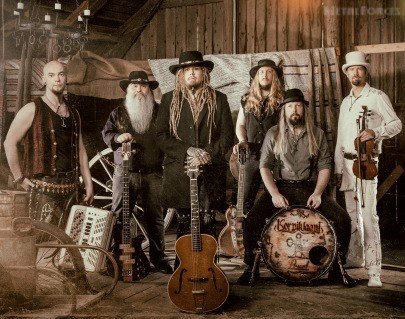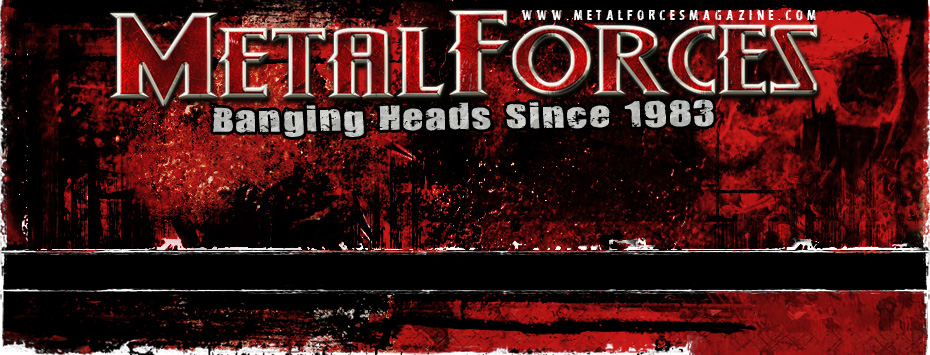
KORPIKLAANI – Travelling Wanderers
Anthony Morgan
September 2018
 Korpiklaani (l-r): Tuomas Rounakari, Matti Johansson, Jonne Järvelä, Jarkko Aaltonen, Kalle Savijärvi and Sami Perttula |
![]()
As was the case with previous outings, much of the tracks penned in support of Kulkija – the tenth full-length studio album from Finnish folk metal outfit Korpiklaani – were authored by lead vocalist Jonne Järvelä. Several tracks written by fellow members always tend to round out affairs, but on this occasion, that tally totals four.
“The process itself went simple because everyone was writing the music in the band by themselves,” informs Jarkko Aaltonen, bassist of Korpiklaani. “We don’t really get together to write anything. Everyone has their own way of working; everyone just records their own demos at home, and then we just keep on sending the files to each other. So, there’s not much to talk about with the writing process (laughs). Anyway, it was interesting this time. At least we got – for the first time – songs from our accordionist Sami (Perttula) for the album, and the violinist wrote his first song for the band.”
The aforementioned numbers are quite driven by the instruments the respective writers play. “Basically, Tuomas (Rounakari) our violinist wrote an instrumental song that is meant for the violin, and then Sami wrote two very nice rock ’n’ roll songs,” the rhythmist lists. “They’re very interesting, but also very accordion-driven as well. I don’t know if people will hear the album and not know this. I don’t know if they will know these differences, but I certainly know the fact that you can clearly hear that those songs are written by the accordionist. There are four songs by people other than Jonne, altogether. There’s two by the accordionist, one by the violin player, and one by me.”
‘Sillanrakentaja’ was the track that Jarkko was responsible for. “It’s the stuff that I always write,” he figures. “I’ve been listening to Tony Iommi for 30-something years; everything that I play on a guitar sounds like Black Sabbath, so that’s what comes out. I’m a crappy guitar player.”
‘Sillanrakentaja’ takes its lyrical cues from familiar territory. “That’s one of the things that we always have, where we take an old Finnish legend or an old story – or whatever you want to call it – and just write lyrics about that,” the four-stringer views. “There’s basically a legend about a bridge builder – the song title translates to ‘Bridge Builder’. A big giant was building a bridge over a lake. When a local woman comes and ridicules the giant, because the giant was a working man with crappy clothes and a dirty body or whatever, the giant gets pissed off and just thinks ‘Fuck it. I quit.’ Now, there’s this half-built bridge across a lake in Finland. There’s an actual place to that legend.”
Writing tracks at large, Jarkko has a specific manner in which he works. “When I write stuff, I just start playing guitar,” he tells. “That’s the only way I know how to work. I start playing guitar. If I happen to come up with a good melody or a good riff, then I start building on one little thing that I found good. I think that’s pretty much the way everyone works, in that they just keep on playing until they come up with something proper to use. I’m very slow; I’m very unproductive. I have songs recorded as half-demos; I have dozens of them on the computer from years back that I go back to every now and then. I then see if I can do something to finish them properly, but no, it’s mostly not happening.”
 |
These half-finished tracks may surface elsewhere. “There’s also another band that I’m playing, which is pretty much a different band,” the composer cites. “It’s sort of easier to write for that. Not everything I do fits the Korpiklaani genre or style, so I do other stuff as well. I’ve never found it a problem, because Jonne always comes up with so much material. He writes a ton of stuff in no time at all, and stuff that is good. Even though I don’t write that much and everyone else doesn’t write that much, we always have plenty of material. There’s just never been a lack of material.”
Kulkija’s different direction caused a slight difference in sound. “After every album, I’ve always said that the next album will be better than the previous one,” Jarkko reflects. “I still think that of all the albums that we’ve done, and I truly think that the next album will be better than the previous one. I think so this time as well, but also the album is quite different – in many ways, actually. The production, the sound. We deliberately went into a different direction. We sort of felt that after the latest album, that there was nothing on that path. We felt that there was nowhere we could go now, and that we were at the end of the path with this sort of production. We wanted to take a few steps back and take a different approach, sort of a fresh approach. We tried to have the album have a more natural sound, like less processed guitars. Then we also wanted the overall sound to be a bit more open, and not so full of everything. We achieved most of it at least, and tried to make an album that sounds better than the previous one.
“There’s a lot of room in the sound; there’s plenty of room for the accordion, and the violin to shine. The vocals are very different; they are very in-your-face, and also the playing is a bit different. We really, really tried to get rid of this ‘Take 46’. We really wanted to use the first or second take, so that the freshness is still there, and then song-wise the album is also… I think not really different than the others, but there are different elements. The old elements of Korpiklaani are still there, but I think we have expanded into different areas musically this time. There’s a bit more mellow stuff on the album and also heavier stuff on the album that people are generally used to hearing from us.”
Mixing folk instruments and more conventional instruments without the two stepping on one another is arguably a difficult task. “That’s always been a little problem,” the lyricist concedes. “Also, that’s always been the constant battle between the players in the band and the producers. Now, we changed the producer on this album, so it was a completely different approach. It’s always been sort of difficult though, because people have different views of what we should be hearing right now. Then when you put in – as you said – the conventional instruments, when you produce those the way modern heavy metal is produced, they fill every hole in the sound.
“That’s very full, and then it’s always been a difficult thing to find the proper sounding spot in the mix for the other instruments. As I said, this time we really tried to avoid that. We tried to keep the rock band part I wouldn’t say lighter, but like less filling in the whole spectrum. It turned out better than we thought, actually. I think the violin and the accordion are very brilliant on the album.”
Conventional Korpiklaani fare arguably occupies Kulkija’s lyrical themes. “Lyrically, we tried to find some new areas to go to, but there are still the old legends and that kind of stuff,” Jarkko concurs. “There’s also still a drinking song and so on, but we sort of tried to move away from the more old school stuff – like less legends, and more rock lyrics but suitable for us if you will. With the themes, that is probably the overall theme. The lyrics are a bit different than they have been, and some of the songs…
“This has happened to us on many albums already where, for some reason, we’ve ended up with a bunch of songs on the album – like fix or six songs – that all deal with the same kind of themes. Although not being a concept album, these songs still give a certain overall theme for the album this time. It was the Travelling Wanderer theme of the album; there are a few songs about that, and that translated into the album title. Then those songs together translated into the album cover art.”
Kulkija’s cover artwork was designed by Jan Yrlund, once again. “As I was saying, it’s about the travelling part where you have the open road,” the performer reiterates. “It is up to the viewer to actually decide if the person is returning or leaving, as that is not said anywhere. The funny thing with the album cover artwork was when I first saw that in sketches, I complained that the water in the background looks so fake. I said ‘There’s no fucking way that the water would fall in that kind of way.’ It just looked really weird to me, and then the artist sent me the fucking photograph of the place. That is an actual place, and I didn’t know that. It’s an actual place, and it’s look exactly like that. That was sort of funny, how I was complaining that it looks fake when it was based on an actual photograph.”
 Korpiklaani (l-r): Sami Perttula, Jarkko Aaltonen, Jonne Järvelä, Kalle Savijärvi, Matti Johansson and Tuomas Rounakari |
 |
![]() Hay bales are situated within the field depicted in the artwork, although this has been mistaken by some. “There’s a bit of a problem with that, because some interviewer already thought that it was a graveyard,” Jarkko elaborates. “It’s metal, so everyone is expecting graveyards and demons. You just need to buy the LP, which is bigger.”
Hay bales are situated within the field depicted in the artwork, although this has been mistaken by some. “There’s a bit of a problem with that, because some interviewer already thought that it was a graveyard,” Jarkko elaborates. “It’s metal, so everyone is expecting graveyards and demons. You just need to buy the LP, which is bigger.”
Sitting in the production chair for Kulkija was Janne Saksa. “We did many albums with our previous producer, Aksu Hanttu,” the bassist muses. “He did a good job with us. We really, really made a lot of progress in many ways with him, but then as I mentioned, we really felt after the previous album, that we need to make some changes to the sound and production. The ideas that we had for what we should do, we knew that that wouldn’t work with Aksu, because we know the guy. We know how he works and what he likes, so that would have just ended continuing with him. That would have just ended in constant fighting in the studio.
“We wanted to have another producer, and Janne had approached us some time earlier, mentioning that at some time if we needed a producer, he was actually interested in producing us. Then we had a chat with him, and realised that he sort of had the same kind of ideas. He felt the same about us, and also felt the same about our previous albums. He understood where we were coming from and where we were wanting to go, so that was quite an easy decision to make. Working with him in the studio was like amazingly easy as well, because the band and the producer had very similar ideas. We pretty much agreed on everything.”
A limited number of takes were required to capture Kulkija’s tracks. “We were quite well rehearsed,” Jarkko reckons. “When it came to the basic, conventional parts, and then when it came to the solos and the vocals, the whole idea was to keep it fresh. For example, we wanted Jonne to have a certain emotion loaded into the lines that he was singing. You can only do that so many times; you cannot fucking keep on pouring your heart out when you’re on take 46, so we made the decision many times that the first, second or third take was what we wanted to hear. Even if there was a tiny little technical error or whatever, when it sounded good, we weren’t going with fucking AutoTune or trying to find other ways to fix the fault.”
The resultant sound causes Kulkija to be slightly more live in nature. “That was also one of the things that we were aiming at, because we released the live album between these two albums,” the rhythmist notes. “While mixing that, we sort of came up with the idea that we could also try to have our album sounding a bit more like what the band actually sounds like. That was the template there, as well; that was one of the factors that led us to changing the production style of it.”
A music video was filmed for the track ‘Harmaja’. “‘Harmaja’ is one of the weird ones on the album,” Jarkko observes. “We’ve always had acoustic stuff on the older albums as well, but they’ve always been some sort of interlude on the album and then with some full blast stuff. This was the first time that we actually put something like that out as a video, so it was really drawing attention to that side of the band. It is very… I would like to use the word ‘beautiful’. It’s very beautiful, and it’s a very sad, even grim text about losing someone. It’s about longing.”
‘Harmaja’ shows a different side to Korpiklaani, away from the fast drinking anthems. “We’ve always had all kinds of stuff on the albums,” the four-stringer explains. “The good thing with this band is that we can basically record anything and it still sounds like us, and we have been doing lots of different kinds of stuff. In the past though, it’s always been ‘Vodka’ or ‘Beer Beer’ or whatever that’s taken most of the attention, or has been released as the first single from the album and so on. This time, we did that a bit differently as well.”
Although depicting an epic, watery scene, ‘Harmaja’’s music video was recorded in less exotic circumstances. “It was a dark night and a stormy sea,” Jarkko jests. “No, it was the rehearsal pool of the Sea Rescue Centre in Finland – it is supposed to be the sea. The water was fucking freezing cold. I know Jonne was complaining when he was singing in the water. He was supposed to imitate the singing of course; he was supposed to do that, and was supposed to look into the camera. He was supposed to have some sort of expression on his face that the director wanted all at the same time that he was fucking kicking with his feet, trying to keep his head above the waves.”
‘Henkselipoika’ acts as the second music video filmed to promote Kulkija’s issue. “‘Henkselipoika’ is a different beast,” the songwriter critiques. “The video sort of tells the storyline of the song. It is the old story of boy meets girl, girl says ‘No,’ boy tries harder, and then girl finally says ‘Yes,’ and they live happily ever after – something like that. It was filmed in two days; the band was filmed in one day at a farm where the director is actually from, and then the rest of the stuff was done in this old kind of place. Most of the actors are related to the band members, like children, or father, or whatever.”
Kulkija was released on September 7th, 2018 via Nuclear Blast Records.
Interview published in September 2018. All promotional photographs by Peero Lakanen.





